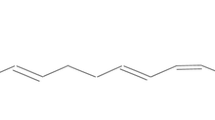Summary
The metabolism of caffeine was studied in isolated rat hepatocytes, in the absence and presence of capsaicinoids. Caffeine and four primary metabolite fractions were identified by high performance liquid chromatography: 1,7-dimethylxanthine, 3,7-dimethylxanthine, 1,3-dimethylxanthine and 1,3,7-trimethyluric acid. The incubation with the lowest concentrations (0.1 and 1 μM) of capsaicinoids (natural extract, capsaicin, dihydrocapsaicin) showed a stimulatory effect on caffeine metabolism, which was further enhanced with capsaicin. At 10 μM, capsaicin stimulated the two pathways of metabolism of caffeine (N-demethylation and C-8 oxidation). In contrast, dihydrocapsaicin and the natural extract seem to inhibit the N-demethylation pathways without affecting the C-8 oxidation route. The inhibitory activity on the N-demethylation pathways and especially the N-7 demethylation pathway was pronounced at the first 30 min of incubation. These results suggest that the two pathways (N-demethylation and C-8 oxidation) are mediated by different isozymes of cytochromes P-450. This is in agreement with recent findings.
Similar content being viewed by others
References
Bouraoui A., Toumi A., Bouchoucha S., Boukef K., Brazier J.L. (1986): Influence de l’alimentation épicée et piquante sur l’absorption de la théophylline. Thérapie, 41, 467–471.
Bouraoui A., Toumi A., Ben Mustapha H., Brazier J.L. (1988) Effects of capsicum fruit on theophylline absorption and bioavailability in rabbits. Drug Nutr. Interact., 5, 345–350.
Gannett P.M., Nagel D.L., Reilly P.J., Lawson T., Sharpe J. Toth B. (1988): The capsaicinoids: their separation, synthesis and mutagenicity. J. Org. Chem., 53, 1064–1071.
Duckles S.P. (1988): Effects of capsaicin on vascular smooth muscle. Arch. Pharmacol., 333, 59–64.
Duckles S.P. (1988): Capsaicin as a probe of the local vascular effects of sensory transmitters. In: Vanhoutte P.M. (ed.). Vasodilatation: vascular smooth muscle, peptides, autonomic nerves and endothelium. New York, Raven Press, pp. 97–100.
Manzini S., Perretti F. (1988): Vascular effects of capsaicin in isolated perfused rat mesenteric bed. Eur. J. Pharmacol., 148, 153–159.
Miller M.S., Brendel K., Burks T.F., Sipes I.G. (1983): Interaction of capsaicinoids with drug metabolism systems. Biochem. Pharmacol., 32, 547–551.
Modeley C.E., Das M., Don P.S.C., Marcelo C.L., Mukthar H. Bickers D.R. (1986): Capsaicin as in vitro inhibitor of benzo (a) pyrene metabolism and its DNA binding in human and murine keratinocytes. Drug Metab. Disp., 14, 413–416.
Bouraoui A., Brazier J.L., Zouaghi H., Rousseau M., Soubeyrand J. (1995): Theophylline pharmacokinetics and metabolism in rabbits, following single and repeated administration of capsicum fruit. Eur. J. Drug Metab. Pharmacokinet., 20, 173–178
Attuquayefio V.K., Buckle K.A. (1987): Rapid sample preparation method for HPLC analysis of capsaicinoids in capsicum fruits and oleoresins. J. Agric. Food Chem., 35, 777–779.
Berry N.N., Friend D.J. (1969): High yield preparation of isolated rat liver parenchymal cells. J. Cell. Biol., 43, 506–520.
Riou J.P., Claus T.H., Pilkis S.J. (1976): Control of pyruvate kinase activity by glucagon in isolated hepatocytes. Biochem. Biophys. Res. Commun., 73, 591–599.
Mulder G.J., Nagelkerke I.F., Tijdens R.B., Wijnands W.J.A., Van Der Mark E.J. (1988): Inhibition of oxidative metabolism of theophylline in isolated rat hepatocytes by the quinolone antibiotic enoxacin and its metabolite oxoenoxacin not by ofloxacin. Biochem. Pharmacol., 37, 2565–2568.
Berthou F., Ratanasavanh D., Riche C., Picart D., Voirin T., Guillouzo A. (1989): Comparison of caffeine metabolism by slices microsomes and hepatocyte culture from adult human liver. Xenobiotica, 19, 401–417.
Campbell M.E., Grant D.M., Inaba T., Kalow W. (1987): Biotransformation of caffeine, paraxanthine, theophylline and theobromine by polycyclic aromatic hydrocarbon inducible cytochrome(s) P-450 in human liver microsomes. Drug Metab. Dispos., 15, 237–249.
Cardo M., Segura J., Delatorre R., Badenas J.M., Cami J. (1989): Effect of quinolones on caffeine disposition. Clin. Pharmacol. Ther., 45, 234–240.
Grant D.M., Campbell M.E., Tang B.K., Kalow W. (1987): Biotransformation of caffeine by microsomes from human liver. Kinetics and inhibition studies. Biochem. Pharmacol., 36, 1251–1260.
Berthou F., Ratanasavanh D., Alix D., Carthant D., Riche C., Guillouzo A. (1988): Caffeine and theophylline metabolism in newborn and adult human hepatocytes: comparison with adult rat hepatocytes. Biochem. Pharmacol., 37, 19, 3691–3700.
Author information
Authors and Affiliations
Rights and permissions
About this article
Cite this article
Bouraoui, A., Brazier, J.L., Zouaghi, H. et al. Effects of capsaicinoids on oxidative metabolism of caffeine in isolated rat hepatocytes. European Journal of Drug Metabolism and Pharmacokinetics 20, 179–184 (1995). https://doi.org/10.1007/BF03189667
Received:
Issue Date:
DOI: https://doi.org/10.1007/BF03189667




